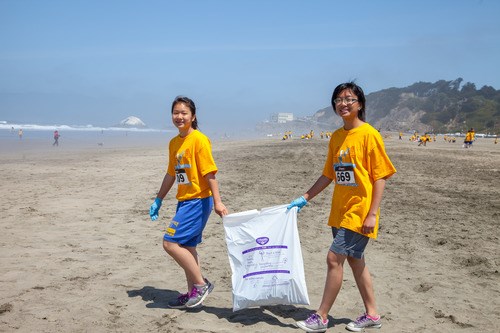
NOAA
The Perils of Plastic
Marine debris is a common pollution problem in oceans and waterways around the world. Plastic debris constitutes one of the most serious threats to ocean health.
Up to 90% of trash floating in the ocean and littering our shores is plastic. Plastics can harm wildlife, damage coastal habitats, impact local economies, and even threaten human health.
How does plastic get into the ocean?
Even if you don’t live near the coast, your plastic waste can still find its way to the ocean. A plastic water bottle blown into the street can travel down a stormwater sewer, into rivers and streams, and out into the ocean.

NOAA
Types of Plastic
1. Consumer Products
Plastic debris comes in many different types and sizes that we buy and use ourselves, including disposable water bottles, plastic grocery bags, fishing net, fishing line, plastic cups and lids, packaging, balloons and plastic utensils. In the marine environment, these types of debris can harm wildlife when animals mistake plastic for food, or accidentally entangle themselves in plastic littering our shorelines or floating in the ocean.
2. Microplastics
Plastic does not biodegrade. Instead, once discarded into the environment, it breaks up into smaller and smaller pieces the longer it is exposed to the sun; a process called photodegradation. Any plastic particle less than 5 mm in diameter is categorized as a microplastic. Although small, these plastic pieces can have huge effects on ocean health.
Microfibers and Microbeads:
Some microplastics can start small and end up in the ocean. Microbeads were used in products such as face scrubs and exfoliators; however, microbeads were being phased out under national law in 2015.
Even clothing sheds microplastics. These "microfibers" are the result of washing polyester, rayon and other synthetic fabrics. In a recent study, microfibers accounted for 97% of all microplastics found in beach sands in national parks. Although wastewater treatment plants filter out the majority of microfibers, some microfibers still pass through their systems and end up in our waterway and oceans.
Effects of Plastic
Plastic poses a serious threat to our oceans and waterways. Birds, turtles, fish, and other marine life ingest the plastic pieces, mistaking them for fish eggs, plankton, jellyfish, or other food sources. Every year, hundreds of thousands of sea creatures, both large and small, die from complications relating to plastic debris – they may have a stomach full of plastic that they cannot digest, or they may become fatally entangled in debris.
Harmful chemical pollutants can also attach to plastics and add to the toxicity of plastic debris consumed by animals. Risks to human health from microplastics in seafood are currently being assessed.
Get Involved

NPS Photo
Even though the perils of plastic can seem overwhelming, individual actions can make a big difference! Be a part of the solution! Heres how:
- Participate in park clean-ups by researching volunteer events when visiting.
- Reduce your use of plastics by using reusable water bottles and reusable grocery bags and by avoiding plastic bags, utensils, plastic wrap, etc.
- Rewear synthetic clothing; if possible, wash it less often.
- Recycle! And always dispose of waste properly-- avoid overflowing trash cans.
- Spread the word! Help protect park beaches and the ocean by telling others about reducing their plastic consumption.
Last updated: May 27, 2025
